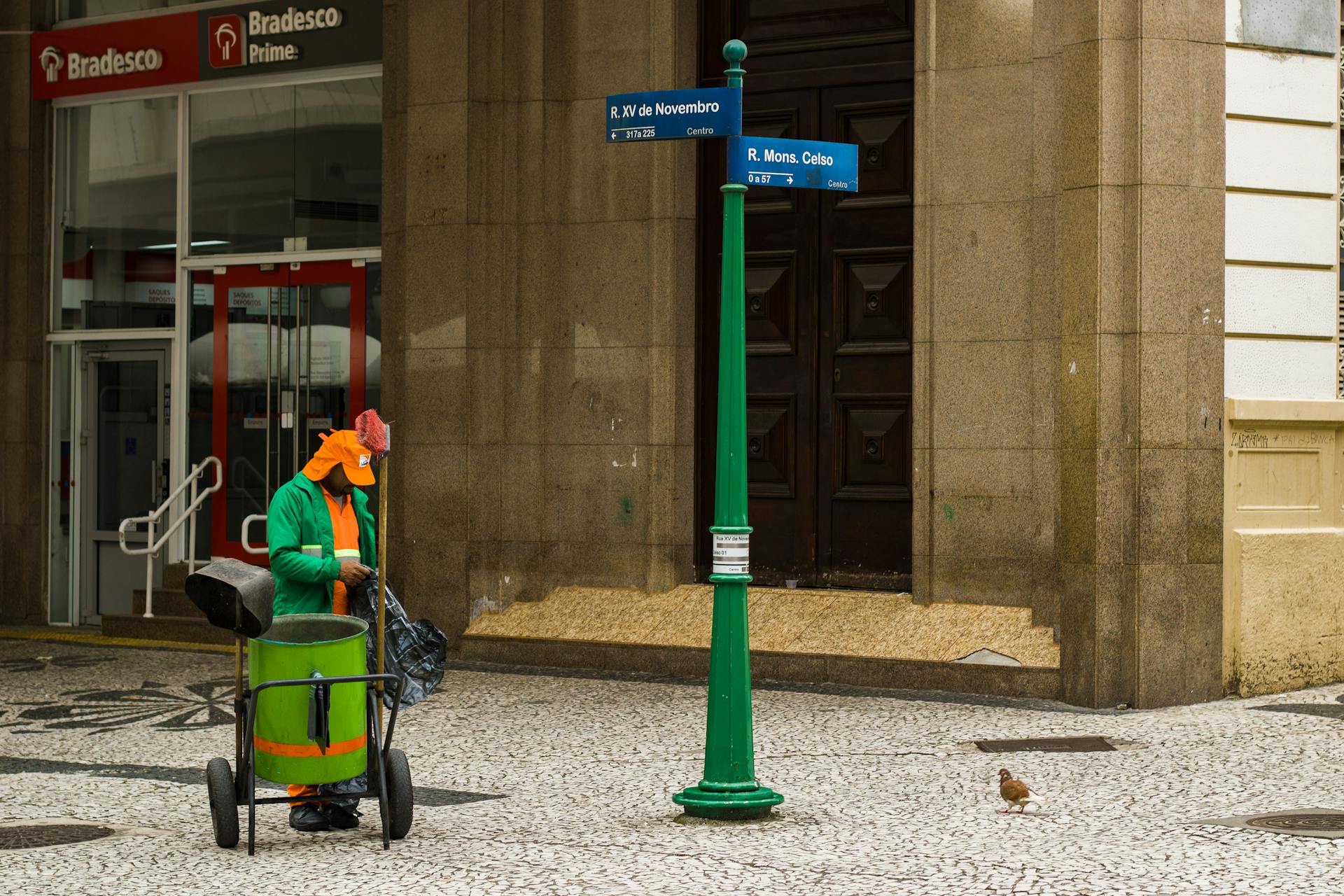
Bradesco Banking has been a leading financial institution in Brazil for over 100 years, with a strong presence in the country's banking market.
With over 70 million customers, Bradesco is one of the largest banks in Brazil, offering a wide range of financial services including checking and savings accounts, loans, credit cards, and insurance.
Bradesco's expertise lies in its ability to adapt to the changing needs of its customers, with a focus on innovation and digital transformation.
The bank has invested heavily in technology, introducing mobile banking and online services that allow customers to manage their accounts and conduct transactions from anywhere.
History of Bradesco
Bradesco has a rich history that spans over 80 years. Founded on March 10, 1943, by Amador Aguiar in Marília, São Paulo, the bank initially targeted small landowners, retailers, and government employees.
Banco Bradesco moved its headquarters to São Paulo in 1946 and quickly grew to become the largest private bank in Brazil by 1951. This rapid expansion continued throughout the 1950s and 1960s, with the bank launching the first credit card in Brazil in 1968.
One notable milestone was the acquisition of 17 banks throughout the country in the 1970s, demonstrating Bradesco's commitment to growth and expansion. Today, Bradesco is a leading financial institution in Brazil, with a strong presence in Latin America and beyond.
Here's a brief timeline of Bradesco's major milestones:
- 1943: BancoBrasileiro de Descontos S.A. founded by Amador Aguiar in Marília, São Paulo.
- 1946: Banco Bradesco moves headquarters to São Paulo.
- 1951: Banco Bradesco grows to become the largest private bank in Brazil.
- 1962: Banco Bradesco is the first Latin American company to buy a computer.
- 1968: Banco Bradesco launches the first credit card in Brazil.
- 1978: Banco Bradesco branch no. 1000 is inaugurated in Chuí at the southern tip of Brazil.
- 1991: Amador Aguiar died at 86 in São Paulo.
- 1996: Banco Bradesco introduces the first Latin American Internet Banking system.
- 2010: Banco Bradesco buys Ibi Mexican subsidiary.
- 2015: Banco Bradesco buys HSBC Brazilian unit for $5.2 billion.
- 2020: Banco Bradesco reaches agreement to acquire JPMorgan Chase & Co.'s Brazilian private banking clients.
- 2022: Banco Bradesco reaches agreement to acquire BNP Paribas Brazilian wealth management operations.
Early Years
BancoBrasileiro de Descontos S.A. was founded on March 10, 1943, by Amador Aguiar in Marília, São Paulo. This marked the beginning of Bradesco's incredible journey.
The bank initially targeted small landowners, retailers, and government employees. This focus on serving the local community helped Bradesco grow and establish a strong presence in Brazil.
In 1946, Bradesco moved its headquarters to São Paulo, a strategic decision that would help the bank expand its reach. This move marked the beginning of Bradesco's growth and success.
Here's a brief timeline of Bradesco's early years:
- 1943: BancoBrasileiro de Descontos S.A. founded by Amador Aguiar
- 1946: Bradesco moves headquarters to São Paulo
- 1951: Bradesco grows to become the largest private bank in Brazil
- 1953: Bradesco moves headquarters to Cidade de Deus, Osasco, São Paulo
- 1956: Amador Aguiar creates Fundação Bradesco, the biggest education program in Brazil
These early years laid the foundation for Bradesco's future success and growth.
Growth and Expansion
Bradesco has a long history of expansion and growth. The bank grew to become the largest private bank in Brazil by 1951.
In the 1970s, Bradesco acquired 17 banks throughout the country, significantly increasing its presence. By 1978, the bank had inaugurated its 1000th branch in Chuí, at the southern tip of Brazil.
Bradesco continued its expansion into new markets, including Mexico and Argentina. In 2010, the bank bought Ibi Mexican, a subsidiary of C&A. By 2015, Bradesco had acquired HSBC's Brazilian unit for $5.2 billion.
In recent years, Bradesco has continued to grow through strategic acquisitions. In 2020, the bank reached an agreement to acquire JPMorgan Chase & Co.'s Brazilian private banking clients. The following year, Bradesco bought a minority stake in American fintech BCP Global.
By 2022, Bradesco had acquired BNP Paribas's Brazilian wealth management operations. The bank has also expanded its presence in the digital banking space, with a focus on high growth potential markets.
Here are some key milestones in Bradesco's expansion:
- 1970s: Acquired 17 banks throughout Brazil
- 1978: Inaugurated 1000th branch in Chuí, Brazil
- 2010: Bought Ibi Mexican subsidiary
- 2015: Acquired HSBC's Brazilian unit for $5.2 billion
- 2020: Acquired JPMorgan Chase & Co.'s Brazilian private banking clients
- 2021: Bought minority stake in American fintech BCP Global
- 2022: Acquired BNP Paribas's Brazilian wealth management operations
Banking Services and Opportunities
Bradesco, a leading bank, has made significant strides in digitalizing its services, starting with a digital process that absorbed over 240,000 payments per year in its first phase.
Xerox's implementation of this process brought about agility in the payment chain and reduced exposure to operational risks.
Ronaldo Lira, Accounts Payable Manager at Bradesco, credits Xerox's digital platform for achieving greater digitization, process optimization, and cost reduction.
The bank's partnership with Xerox has been instrumental in speeding up processes and reducing the need for paper and printing.
Bradesco's expansion into digital banking has high growth potential, according to Octavio de Lazari, the bank's CEO.
The acquisition of Xerox's services will enable Bradesco to expand its operation and become a digital bank with a greater presence in the Mexican market.
Bradesco's decision to go digital comes as a response to rising competitors, including Nubank, which has rapidly expanded across Latin America and has almost 65 million clients.
Sources
- https://en.wikipedia.org/wiki/Banco_Bradesco
- https://www.fintechnexus.com/brazils-banking-giant-bradesco-to-create-digital-bank-in-mexico/
- https://www.oracle.com/customers/bradesco-bank/
- https://wise.com/us/swift-codes/BCBBBRPRRCE
- https://mx.america-digital.com/xerox-and-bradesco-evolution-of-banking-with-digital-billing/
Featured Images: pexels.com


